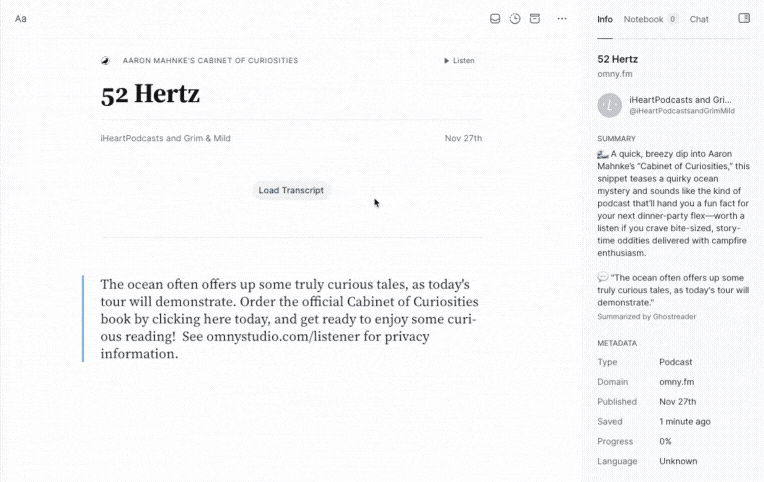Adding Content to Reader
What's the difference between Library and Feed?
Reader has two broad sections: Library and Feed. Library is further subdivided into a handful of locations like Inbox, Later, Archive, and Shortlist (depending on your Library configuration). Library is where things go that you manually curate for yourself and choose to save permanently, such as articles saved from the browser extension or uploaded EPUB documents.
The Feed is where things go that are automatically pushed to you, such as RSS feed content, and it's divided into two locations: Unseen and Seen. As you find documents in Feed that you want to read later and/or permanently save, you can move them to your Library.
How do I use the browser extensions to save articles to Reader?
The Reader browser extension performs two functions: first, saving articles to Reader and second (optionally), highlighting the open web. To save a document to Reader, tap the icon in the browser bar or use the keyboard shortcut alt + R. (You can change the keyboard binding in the extension's options.) This will save a clean, readable version of the document to your Reader inbox.
Once you've tapped the icon, you can optionally begin highlighting on the website itself, or you can click the Open article in Reader button to switch the Reader app and take your highlights there.
The browser extension is the most robust way to save documents to Reader because the extension gets the underlying content rendered in your browser as opposed to just a URL.
How do I install the browser extension for Reader?
If you're using Google Chrome, you can install the Reader extension from the Chrome web store. The Reader browser extension is compatible with any browser built using Chromium, including Brave, Edge, and Arc.
If you're using Firefox, you can install the Firefox extension from the Firefox Add-Ons.
If you're using Safari, you can install the Safari extension from the App Store.
My Chrome extension is asking for an API token. What do I do?
This is not actually the official Chrome extension made by Readwise, but rather an extension made by someone in the community. You should not use this extension with Reader. Instead, install the official extension from the Chrome web store.
How do I use a keyboard shortcut to save documents to Reader using the browser extension?
By default, you should be able to tap Alt + R to save a document to Reader using the browser extension. If you're using Chrome or a Chromium-based browser, you can edit this shortcut for the browser extension here: chrome://extensions/shortcuts.
How do I use the mobile app to save articles to Reader?
Once you have the mobile app installed on your iOS or Android device, you can share documents to Reader using your mobile operating system's share sheet.
If you don't see Reader among the apps you can share to, try restarting your device. Sometimes iOS has a bug where new apps do not immediately appear in the share sheet, but a restart should clear that up.
Saving from Safari is the best way to save documents to Reader on mobile because iOS gives our app access to the underlying content in addition to the URL resulting in better parsing.
How do I install the Reader iOS app?
You can install the Reader iOS app from the App Store. This will work on any device that can run iOS 13.0 or later (iPhone, iPad, etc).
How do I install the Reader Android app?
You can install the Reader Android app using this link from the Google Play Store.
Note that this version of Reader will also work on e-ink devices that run Android, such as the Onyx BOOX.
How do I upload files to Reader?
You can upload a variety of different file types to Reader, including PDFs, EPUBs, and OPML files. To upload a file, drag it on top of the web app, or open the Upload dialog (keyboard shortcut: U) and select the file.
On mobile, use the "share" action from within your device's Files app and find the option in the share sheet labeled "Upload [file] to Reader".
How do I add podcasts to Reader?
You can share a podcast link to Reader to save a high-quality transcript of the content in your Reader Library, which you can then highlight, chat with, or use with any of Reader's other features.
To save a podcast on mobile, find an episode in your podcast player of choice (we currently support Spotify, Overcast, and Apple Podcasts) and use that app's share option to share the episode to Reader.

On web, you can add podcasts by copying the link and pasting it into Reader via the Add URL option (keyboard shortcut A).
If you subscribe to any podcasts using RSS, you can manually trigger the transcription for each episode. To do so, use the Load transcript button at the top of the episode's content.

Podcasts are a distinct content type, and you can find all of the podcasts you've saved in the Podcasts section of your Library.

You can also use category:podcast or type:podcast in any filtered view query to include podcasts in that view.
Why can't I listen to my podcast inside of Reader?
We intentionally built this feature to allow Reader to be a podcast companion, rather than a full podcast player. You can read more about why we chose to build it this way in our public beta update #13.
How do I save Twitter threads to Reader?
You can save Twitter threads to Reader and they'll compile into beautiful, blog-like documents. To save a Twitter thread, you can use the browser extension while viewing the page of any tweet in the thread. (Note that this will only save tweets posted by the OP in their original thread, not any replies from other users.)
If you're on mobile, you can use the share sheet to share any tweet of the thread to Reader.

How do I configure where individual tweets and Twitter threads go between Reader and Readwise?
Users have many different preferences on where they want to save individual tweets and threads. By default, we make the assumption that individual tweets are like highlights and therefore go into Readwise, whereas Twitter threads are like articles and therefore go into Reader. If you want to change any of this, you can customize the Twitter behavior on the Integrations page.
How do I add Twitter lists to Reader?
You can subscribe to public Twitter Lists in Reader as if they were an RSS feed. It's a great way to separate the good parts of Twitter (high signal information/entertainment) from the bad parts (phone addiction?). Once you're subscribed to a Twitter List, you'll start receiving two digests per day in the AM and the PM containing all the new tweets over the past 12 hours. To subscribe to a Twitter List, find the URL of a public list and subscribe to it in the Feed section of Reader.
Can I read my Kindle/Google/Apple/Kobo/etc books in Reader?
If you purchased a book on a different platform that doesn't provide an option to download a DRM-free EPUB file, you won't be able to import that book to Reader. Those other platforms intend for the books they sell to be read within their own ecosystem (e.g. Amazon wants you to read on a Kindle or in their app), so they don't provide a way for the books to be exported to third-party services like Reader.
For books that are in the public domain, you can find many places online to download EPUB versions. We like Standard Ebooks for their dedication to quality proofreading and modern formatting.




